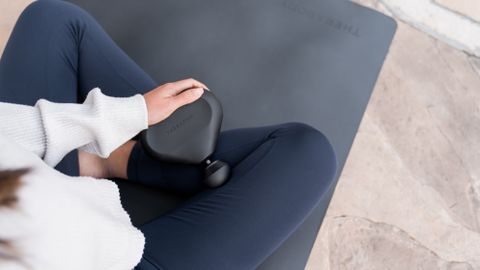Tom's Guide Verdict
The Theragun Mini is a fantastic option for travel, but lacks some of the features that other massage guns offer.
Pros
- +
Extremely portable
- +
Ergonomic design
Cons
- -
Expensive for what it offers
- -
Only one attachment
- -
Shorter amplitude and less power than other Theragun models
Why you can trust Tom's Guide
Dimensions: 6 in x 5.3 in x 2.25 in
Weight: 1.43 pounds
PPM range: 1750-2400 (3 speeds)
Amplitude: 12mm
Attachments: 1
Noise level: 50-65 decibels
Battery life: 150 minutes
Battery charge time: 80 minutes
The Theragun Mini takes all the benefits of percussive massage and wraps everything in a very small and light package. But is Theragun’s miniature offering powerful enough to be your one-and-only massage gun?
The best massage guns offer an easy way to release muscle tension, warm-up for an activity, and prevent potential injury. The fast percussion from the gun and its attachments dig into muscle, promoting tissue relaxation and blood flow. While they’re not as unwieldy as foam rollers, they still tend to be somewhat bulky and hard to manage, making them unfriendly travel companions.
That’s where the Theragun Mini stands out from the crowd. Read our full review of the Theragun Mini below.
- Train like a pro: The best adjustable dumbbells for weight lifting at home
- The best exercise bikes for upping your cardio indoors
- The best shoes for Peloton and indoor cycling
Theragun Mini review: Price and Availability
It might be mini in name and size, but it’s not exactly mini in price: At $199, the Theragun Mini falls solidly into a mid-range category of massage guns. Sure, there are some that are way more expensive (like the Theragun Pro at almost $600), but you can definitely find one for cheaper (like the Sportneer Deep Tissue Massager at $89.99).
Pricing remains the same among all the major retailers. Sales on Therabody products aren’t frequent, so if you find one happening, you may want to pull the trigger and purchase.
The Theragun Mini comes in three colors: white, black, and desert rose. A PRODUCT(RED) version of the Mini is also available.

Theragun Mini review: Design
One thing is for certain — you won’t find any other massage gun that looks like the Theragun Mini. Shaped like a thick and oversized guitar pick, the Mini fits comfortably into your palm and allows you to apply adequate pressure to the muscle groups you’re targeting. My hands are a little smaller than average, and I never had a problem getting a comfortable and secure grip. If your hands are exceptionally small, you may run into some issues. But overall, the Mini’s solid triangular design is as ergonomic as promised.
The Mini is capable of three speeds: 1750, 2100, and 2400 PPM (percussions per minute). This is an acceptable enough range, although competing models like Legiral Le3 Massage Gun have a lot more variety in PPM (at less of an expense). Adjusting the speed is done through a sole button on the side of the device, with three lights indicating the current PPM.
Beyond percussions per minute, a key factor in any massage gun’s strength lies in its amplitude — the distance the shaft and attachment extend from the gun and into your muscle. At 12mm, the Theragun Mini’s amplitude is about average. Springing a hundred dollars more for the Theragun Prime will get you a 16mm amplitude, and ostensibly, a deeper massage.
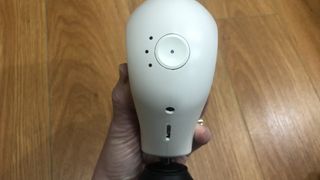
That extra hundred for the Prime will also get you four attachments, as opposed to the single “standard ball” that comes with the Mini. All things considered though, the standard ball is a good catch-all attachment that can be used effectively on most parts of the body. This is especially true given the fact that Theragun attachments are composed of closed-cell foam instead of rigid plastic or hard rubber, both of which have a tendency to be unforgiving on bony areas or extremely tight knots.
It’s also important to note that the Theragun Mini is compatible with all of Theragun’s 4th generation attachments. So if you own another current Theragun model, you could always pop any of their attachments onto your Mini. If you don’t, attachments can be purchased separately.
The Mini fits snugly into a neoprene case that closely resembles your kid’s tricycle seat. It’s small enough to fit into almost any bag, backpack, or suitcase without taking up a lot of space. In a pinch, it could even fit into an oversized pocket in your winter coat. And since the Mini weighs in at just over a pound, you might forget it’s there.
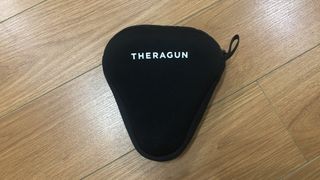
Theragun Mini review: Performance
Therabody boasts that the Mini’s QX35 compact brushless motor harnesses all the power of a Theragun in a much smaller package, retaining both its sound insulation and treatment quality. This is partially true — the Mini never exceeded 65 decibels during usage, and stayed mostly in the 60-63 decibel range. This is a little quieter than the Theragun Elite that I tested, which got as loud as 70 decibels. It’s a lot quieter than models like the LifePro Sonic Handheld Percussion Massager, which can clock up to 75 decibels.
But as far as power goes, you’ll definitely notice the difference between the Mini and the more expensive Theragun models like the Prime, Elite, and Pro. Because of the Mini’s shorter amplitude, you’ll have to apply more pressure to get a comparably deep massage. But with only a 20-pound maximum additional force, pressing too hard will cause the shaft to slow down, stall, or recoil.
This happened to me on several occasions while testing the Mini. For the most part, even with the smaller amplitude, I could set the Mini at 2400 PPM and feel relief on my trigger points without too much supplementary pressure. But when it came to a few problematic areas, like my lateral quadriceps and glutes, I had to really dig in to feel the release. This caused the gun to slow down a few times, and recoil on me once. That never happened during my testing of the Theragun Elite.
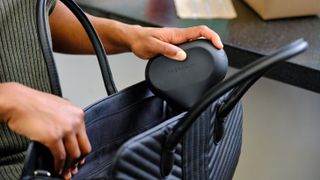
Still, I was able to use the Mini effectively on most of my hot spots. I actually preferred using the Mini over the Elite on my calves, which can be painful to massage (but desperately need the attention). I also liked using the Mini on my lower and mid back — the shorter amplitude was more tolerable, and the Mini was easier to maneuver than the Elite.
The battery is decent on the Mini, with a two and a half hour life. I only needed to charge it once, and it lasted for an entire week’s worth of testing. Charging time was also decent — it took a little under an hour to power the Mini from a low charge to a full one. If your Mini is completely dead, expect a charge time of an hour and twenty minutes.
Where the Theragun Mini really excels though, is in its portability. I was able to bring the Mini with me anywhere I went. It fit in my gym bag, in my backpack, even in one of my smaller purses, and I never noticed any extra weight or bulk. And due to its relatively dense design, I didn’t worry about it getting broken or tossed around too much during transport. This feat would be nearly impossible with any of the pricer Theragun models, or competing guns like the TimTam Power Massager. Not that you couldn’t travel with these models, but you’d definitely know they were there (and in some instances, you may even have to carry them separately).
Theragun Mini review: Therabody App
Therabody takes all of the guesswork out of using Theragun products with the Therabody App. Its extensive library has programming for a wide range of ailments, warm-up and recovery plans for specific sports and activities, and even methods to address better sleep health and overall wellness. Diagrams within each routine tell the user where to place the gun, the PPM setting to use, and how long to massage each area with an in-app timer. Connect the app to your phone or fitness tracker, and you’ll get personalized programming suggestions based on your activity.
The Therabody Prime, Elite, and Pro go a step further with Bluetooth connectivity, which automatically sets the gun to the appropriate PPM and tells the user when they’re applying an optimal amount of force. This is a very helpful feature for those of us without a lot of massage gun experience and allows even the non-athlete to fully reap the benefits from their Theragun.
The smaller, less-expensive Theragun Mini lacks that Bluetooth connectivity, so while you’ll still be able to utilize all of the programs in the app, you won’t have as much guidance or feedback. Since the Therabody app is free and doesn’t require the purchase of a Theragun product to download, there’s fundamentally no difference between using the Mini to follow along, or purchasing a cheaper massage gun and doing the same.
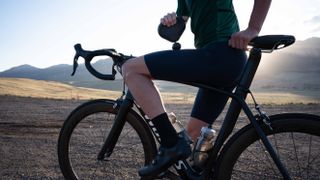
Theragun Mini review: Verdict
If portability is your main concern, you’d be hard pressed to find a better option than the Theragun Mini. It’s incredibly lightweight, compact, sturdy, and would fit even into the smallest of carry-ons or gym bags. Easy to throw in your backpack for marathon day, or your jacket pocket before hitting the slopes, the Mini is a fantastic travel-friendly companion for your larger massage gun.
That being said, the Theragun Mini is expensive for what it provides. There are other (albeit larger and heavier) guns on the market with deeper amplitudes, a greater PPM range, more power, and multiple attachments for around the same price or cheaper. If you’re planning on using your massage gun strictly in the comforts of home, it would be worth shelling out the extra money for a Theragun Prime or Elite, or looking at a competitor like the Hyperice Hypervolt Plus.
Jennifer Rizzuto is a freelance writer and certified personal trainer based in Long Island, NY. She covers various fitness-related topics and reviews for Tom's Guide. She also writes sketch comedy and short films, and performs frequently as an actor, singer, and improviser. When she's not writing, working out, or performing, you'll find her trying to convince her husband to get a dog.
